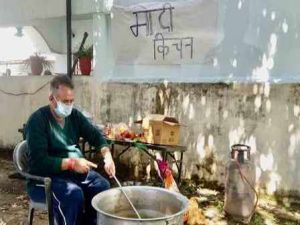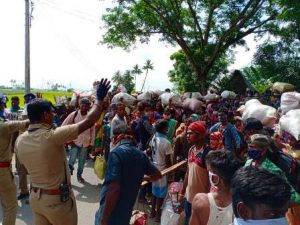Response to COVID-19: Governance of Indian States During Disasters
Uttarakhand is generally proactive as its one of the pioneering state that has created the disaster management department with district-level infrastructure active throughout the year.

Lockdown 3.0 in India is extended for the next two weeks that culminates on 17 May 2020. There is no stopping of COVID-19 cases reports in different states. As per worldometer, on 15 May 2020, India has 82,834 total cases of coronavirus and 2,657 deaths with a fatality rate of 3.2 per cent. India’s control and containment of this respiratory disease are one of the best in the world.
One such state is Uttarakhand that needs special mentioning here in the light of the current approach to fight the pandemic threats. For the hilly state, climate-induced and natural disasters used to happen in past at regular intervals. This is for the first time that a pandemic has been added to the list of disasters. Carved out of Uttar Pradesh in 2000, this hilly state is has come up a long way, accumulated experience and expertise to face different types of disasters.
Uttarakhand Approach to fight COVID-19:
The state reported first-ever COVID-19 case in an Indian Forest Service (IFS) trainee who returned from an exposure tour to the USSR and Finland. Ever since, there has been a gradual increase in positive cases in the state. For prevention and control of COVID-19, Uttarakhand has largely followed the guidelines given by the Government of India (GoI). Uttarakhand is generally proactive as its one of the pioneering state that has created the disaster management department with district-level infrastructure active throughout the year. The communities have a huge penetration of non-governmental and social organization, which are trained and enquired in disaster management. A sizeable number of retired and working defence and paramilitary service population have also served in maintaining the discipline, social distance and quarantine in abiding the rules imposed by the state and GoI in management of Disaster Management Act.
Also Read : Covid 19 On The Crime And Domestic Violence Graph Of India What Lies Ahead
Early Trends from Uttarakhand
Being a close-knit community, Uttarakhand got early success in preparing a detailed list of suspected persons having some travel history (with their contact details and place of migration) for each of the urban ward/rural settlement with the help of ULB and PRIs. State government formed a state-level COVID-19 control room for the tracking of suspected persons, which is working for more than 18 hours a day. After 3 weeks, they formed the City Task Force (CTF) and Village Task Force (VTF) that tried to control civil supplies, tracking of the persons, health check-ups cleanliness drive, etc. It was found that the people with travel history were kept at home quarantine status.
Suresh Chandra Khanduri, Co-Convenor of Inter-Agency Group (IAG), Uttarakhand, stressed that data triangulation by the government has been done at three levels: State Task Forces headed by DMMC, Integrated Disease Surveillance Programme and Law & order department to distribute food. IAG is a consortium of international agencies ensuring minimum humanitarian standards in disaster risk reduction and management with unified action and improved coordination with government and civil society bodies in the state.
He said, DMMC, Dehradun was instrumental in breaking the inertia of government to respond to COVID-19 and facilitated the inclusion of NGOs, CBOs, PRIs and ULBs into the fold of State Task force much earlier.
Empowering stakeholders and building trust and enabling an environment where staff can contribute their best and develop their potential.
Returnee Surge in Ganjam, Odisha

The recent outbreak in Ganjam, the southern district has created havoc in the state. Till 2 May 2020, the positive cases in Uttarakhand stood at 58, with no death and Odisha was 157 with a death report. With lakhs of migrant workers expected to arrive in Ganjam from the hotbeds of Gujarat, Maharashtra, Tamil Nadu and Karnataka, further rise in cases is inevitable. Ganjam is leading the district tally with 210, the district data alone, Odisha figure would cross 1,000 mark in a couple of days. To provide basic facilities at the place of arrivals, transit to TMC and IQC, food and security, adequate infrastructure are not created. The surge will put enormous pressure on COVID-19 testing centres and capabilities.
Data Capture, Sharing and Decision Making
In an epidemic situation, epidemiological data would have been showing road maps to handle a pandemic situation. But the surge of migrant workers, coming from far off places to native places generate data from which pathways for disease spread, therefore, contact tracing and testing and rehabilitation are needed. Migrant workers, those were interested to return were asked to register their personal details, place of work and domicile online. Every state has widely publicised these digital platforms. At household levels, local ASHA, AWW and teachers do collect data on the migrant workers.
Odisha Government on 24th April 2020, launched a portal (www.covid19.odisha.gov.in) for registration of names to contain the spread of Covid-19 pandemic. Within 48 hours, more than 4.50 Lakh migrant labourers registered on it. Eighteen days passed, Odisha government haven’t been able to make public segregated data on migrant. From informal sources, it is believed that the figure might cross 12 lakhs mark. At field level, there is a huge data mismatch and validation is needed. Whatever might be the case, trouble started to facilitate stranded workers back home and providing them services at Temporary Medical Camps (TMCs) and Institutional Quarantine Centres (IQCs).
Table: Comparison between Two Disaster Prone States
| Details | Uttarakhand | Odisha |
| Formation of State | 7 November 2000 (19 years) | 1 April 1936 (84 years) |
| COVID-19 Case | 15 March 2020 | 16March 2020 |
| Total Outbreaks | 68 confirmed (1 death) | 538 confirmed (3 deaths) |
| Leadership | T. S. Rawat, the Chief Minister(since 2017) | Naveen Pattnaik, the Chief Minister (Twenty Years) |
| Major Recent Disasters | Uttarkashi Earthquake 1991
North India Flood, 2013 |
Odisha Supercyclone, 1999
Fani Cyclone, 2019 |
| Key Department for Disaster Management | Disaster Management Department | Special Relief Commissioner (under Revenue Department) |
| Districts | 13 | 30 |
| Policy and Governance in Disaster | UKDMA (2005) | OSDMA(2005) |
| Institution Building | Disaster Management Mitigation Centre (DMMC), coordinating in COVID-19 crisis | State Institute of Disaster Management(Under Construction) |
| Natural and Climate-induced Disasters | Himalayan Mountain Rangein north | Bay of Bengal in east |
| Approach | Decentralised, participatory and output & impact-driven, civil society and EAG | Centralised, logistics driven, Input and media-driven, reshuffle and transfer of officials |
Source: As on 13 May 2020 (Data Source: Departments of Uttarakhand Odisha Government portals)
Institution & Capacity Building on Disaster Risk Reduction
In the last twenty years, Odisha State Disaster Management Agency (OSDMA), Bhubaneswar could be able to function outside the state secretariat but has not yet integrated pandemic into its list of activities.
The last JE and AES in Malkanagiri and Jajpur (Nagada) were not included in it. OSDMA was the first body in India to come up with Disaster Management Policy for the states, as early as 2005. Incidentally, the National Disaster Management Act was formulated in the same year. Unfortunately, OSDMA couldn’t evolve much, while GSDMA, Ahmedabad, successfully established Gujarat Institute of Disaster Management (GIDM). Of late, the SAARC Disaster Management Centre is also functioning from GIDM.
Decentralisation of PRI and ULBs
Also Read : Odisha Fights Coronavirus And Set Example For Many Other States
Local governments are like a link between government and population in a pandemic situation. GoI has decentralised PRIs and ULBs through 73rd and 74th Constitutional Amendment Acts. Interestingly, Uttarakhand has seen eight Chief Ministers in last 20 years while Odisha has the only name, Naveen Pattnaik, who was leading the state from the rubbles of supercyclone in 1999 till date. He has got the popular mandate, 5th consecutive times to lead the state next four years, till April 2024.
In between, the BJD-led government will be facing ULB and PRI elections for which the party workers are quite thoughtful. The last PRI election in Odisha was a setback to the BJD party and, the fear of defeat hunt leaders to delay it. In between, the FANI cyclone (2019) devastated two cities—Bhubaneswar and Puri—and the inordinate delay in rehabilitation and restoration of essential services could be done much earlier. This time, Odisha is fighting COVID-19 with some structural insufficiencies: ULBs are leaderless for last 20 months and No ULB members are involved in COVID-19 crisis; Under capacitated PRI members with 50 per cent female PRI members (Proxy Leaders); Sarpanchs are given with Magistrate power but their financial powers are curtailed; Media advisory issued to media organizations not to report any news at the port of arrivals, train stations, TMCs and IQCs; No involvement of NGOs/CBOs in awareness, risk communication and mobilization; Multiplicity and contradicting government orders to confuse district response team.
On the other hand, Uttarakhand is already free from any such electoral burden in the near future. Uttarakhand has already completed election to ULBs in 2018 and PRIs in 2020, respectively. The newly elected PRI and ULB representatives are working in COVID-19 response team in contact tracing, community mobilization, referral, testing and rehabilitation. The elected local representatives are working in full swing in tandem with the state task force.
‘Total early detection and rapid response’ was the mantra of Larry Brilliant, on the eradication of smallpox in Indian states. In the 1970s, Larry Brilliant was one the leaders of the successful WHO smallpox eradication programme. The Mantra for smallpox eradication applies to COVID-19 too.
